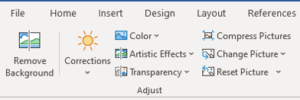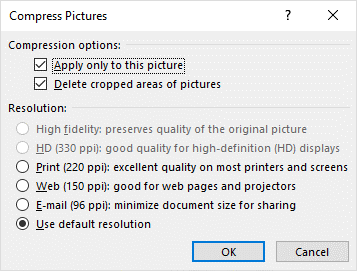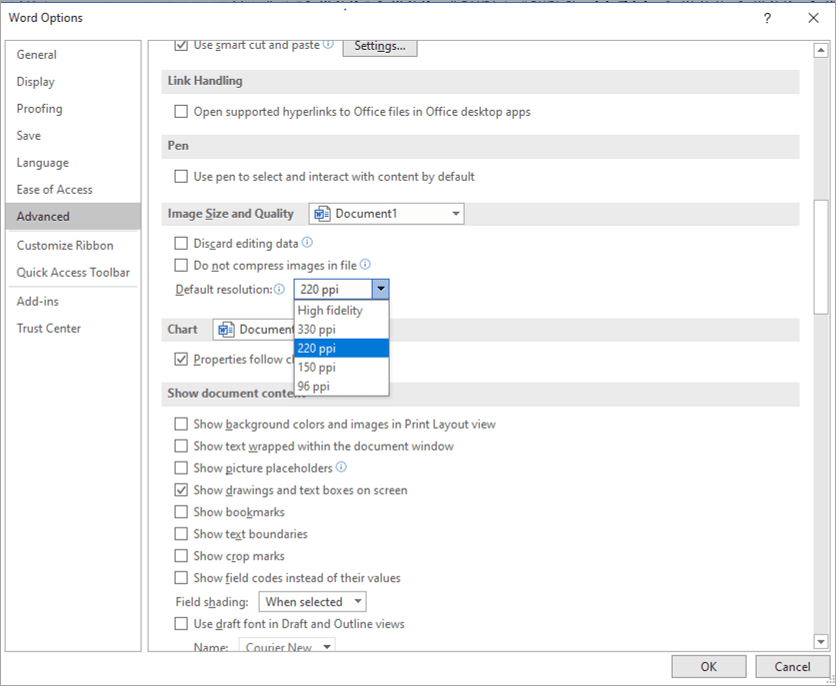Compress Images in Large Microsoft Word Documents (10 Ways)
by Avantix Learning Team | Updated November 15, 2022
Applies to: Microsoft® Word® 2010, 2013, 2016, 2019, 2021 or 365 (Windows)
You can compress images in several ways in Microsoft Word documents to reduce the size of the file. There are built-in Word compression features you can use to make large files smaller but you can also reduce image size before you insert pictures into your documents. If you're using Microsoft 365, 3D models can cause a significant increase in file size.
The following are 10 ways to compress images in Word documents:
- Compress pictures using Compress Pictures on the Ribbon in Word
- Compress pictures when saving a Word document
- Change default compression settings in Word Options
- Insert pictures instead of copying and pasting
- Use image files at a lower resolution
- Convert images to a different file type
- Replace 3D models with 2D alternatives
- Save a copy of images with picture effects
- Discard editing data
- Link to images
Note: Buttons and Ribbon tabs may display in a different way (with or without text) depending on your version of Microsoft Word, the size of your screen and your Control Panel settings. For Word 365 users, Ribbon tabs may appear with different names. For example, the Picture Tools Format tab may appear as Picture Format.
To view file size in Microsoft Word:
- Click the File tab in the Ribbon.
- Click Info. In the Properties area, file size is listed beside Size.
You may want to try most of the following techniques in a copy of the Word document.
Once you've completed one or more of the following strategies, close and save the Word file, reopen it and check the file size again. You can also view file size in Windows 10 File Explorer or Windows Explorer in older versions of Windows.
Recommended article: How to Create a Table of Contents in Word
Do you want to learn more about Microsoft Word? Check out our virtual classroom or live classroom Word courses >
Compress pictures using Compress Pictures on the Ribbon in Word
One of the most common ways to reduce file size is to compress one or all of the pictures in your Word document using Compress Pictures. You may want to try this with one picture at a time to be sure you are satisfied with the result after compression.
To compress a picture in a Word document:
- Select the picture.
- Click the Picture Tools Format or Picture Format tab in the Ribbon in Word.
- In the Adjust group, click Compress Pictures. A dialog box appears.
- Select the check box to Apply only to this picture if you want to compress only the current picture or uncheck this option if you want to compress all pictures in the presentation.
- Select the check box to Delete cropped areas of pictures if you have cropped images and want to permanently delete the areas you have removed by cropping.
- Choose the desired document resolution.
- Click OK.
Compress pictures appears on the Picture Tools Format or Picture Format tab in the Ribbon:
Below is the Compress Pictures dialog box:
Select the target output resolution that is most appropriate for the way you want to use the file. Select E-mail (96 ppi) for maximum compression. Use Web (150 ppi) if you plan to post your Word document online. Choose Print (220 ppi) if you intend to print. HD options (such as 330 ppi) are available in newer versions for high-definition displays.
If a picture has already been compressed, higher-resolution compression options may not be available. For example, if you've saved a Word document and the default 220 ppi compression in Word options is set, you won't be able to compress an image again using 330 ppi (HD).
Images that are downloaded from the internet may already be compressed so higher-resolution compression options may not be available for an image. Also, although Word will allow you specify compression settings for CMYK images, it won't actually compress them.
Don't forget to check pictures in headers and footers.
Compress pictures when saving a Word document
You can also compress all images when you save a Word document.
To save a Word file and compress images:
- Open the Word file.
- Click the File tab in the Ribbon.
- Choose Save As. If necessary, click Options or More Options. A dialog box appears.
- Navigate to the desired location and name the file with a different name (such as OurServices2).
- Click Tools. A drop-down menu appears.
- Click Compress Pictures. A dialog box appears.
- Select the desired resolution.
- Click OK.
- Click Save.
Change default compression settings in Word Options
Word compresses pictures by default based on settings in Word Options. If you set the default to a lower resolution, this should reduce file size. It's important to note that the compression settings are applied when you save the Word document and only to the current file.
To change automatic compression settings:
- Open the Word file.
- Click the File tab in the Ribbon.
- Click Options. A dialog box appears.
- In the categories on the left, click Advanced.
- In the Image Size and Quality settings, choose an option for Default resolution. If you turn off compression completely, your file size would not be compressed.
- Click OK.
Below is the Word Options dialog box with resolution settings in 365 (resolutions are different depending on version):
Higher resolution options are not available in older versions of Microsoft Word. You can change the automatic picture compression for the current file only so it's best to change compression settings when you first create a Word file.
Insert pictures instead of copying and pasting
It's best to insert pictures, rather than copying and pasting (or dragging and dropping) into the Word file. When you copy and paste (or drag and drop) an image into a document, it can lose compression, change file type and also bring in other data that can increase file size.
To insert a picture into a Word document:
- Position the cursor where you want to insert the picture.
- Click the Insert tab in the Ribbon and click Pictures (2013 and later versions) or Picture (2010). You can also click the Pictures or Picture icon in a placeholder on a slide. A dialog box appears. If necessary, click Work Offline.
- Navigate to the location of the picture.
- Select the picture and click Insert or double-click the picture.
You also have the option of linking to a picture file by clicking the arrow beside Insert in the Insert Picture dialog box and then choosing Link to File. However, the picture is not actually "in" the file (which reduces file size) and if you email the document, the pictures will not be included. If you use this strategy, it's best to copy the picture to the same folder as the Word document and be sure to bring the entire folder with you when you deliver the presentation.
Use image files at a lower resolution
It's best to insert pictures in smaller sizes to reduce the size of your Word files. For example, if you are inserting pictures from a stock photo site, select the lowest resolution possible at the quality level you require. It you're taking pictures with a phone, save or send images at a lower resolution and insert the lower resolution images into your PowerPoint decks
You can also open an image in an image editing program (such as Microsoft Picture Manager or Adobe Photoshop) and then save it at a lower resolution.
Convert images to a different file type
You can save pictures in Word, delete them, and reinsert them into the Word document. For example, you could save a TIFF (Tagged Image File Format) image as a JPG (Joint Photographic Experts Group) or PNG (Portable Network Graphics) and reduce the size of the image.
To save an image in a different format and reinsert it into a Word document:
- Right-click the picture. A drop-down menu appears.
- Select Save As Picture. A dialog box appears.
- Navigate to the folder where you want to save the image.
- Enter a name for the file and select a format such as JPG or PNG (PNG supports transparent backgrounds).
- Click Save.
- In the Word document, delete the original image.
- Position the cursor where you want to insert the image.
- Click Insert and then click Picture(s). If necessary, click Work Offline.
- Navigate to the location with the image you saved.
- Double-click the image.
Save a copy of images with picture effects
When you apply picture effects, including artistic effects, to an image, Word retains two copies of the image (the original and a copy with the picture effects). This allows the user to reset the image but can significantly increase file size. Compressing pictures also doesn't normally have any effect on images where you have applied artistic effects.
If you have applied picture effects to an image, you can reduce file size using the following method:
- Right-click the image with the picture effect(s). A drop-down menu appears.
- Select Save As Picture. A dialog box appears.
- Navigate to the folder where you want to save the image.
- Enter a name and select a file type (such as JPG or PNG).
- Click Save.
- In the Word document, delete the original image.
- Position the cursor where you want to insert the image.
- Click Insert and then click Picture(s). If necessary, click Work Offline.
- Navigate to the location with the image you saved.
- Double-click the image.
Replace 3D models with 2D alternatives
In Word 365, you can insert 3D models which can be very large in size. Although 3D models are not inserted as pictures but rather as 3D models, they are images. One model we inserted took 17 MB of space. You can't compress 3D models like other types of images so you may need to delete them or use a picture instead if file size is an issue.
To replace a 3D model with a 2D picture:
- Click the 3D model (it should be set to inline).
- Press Ctrl + X to cut it (to the clipboard).
- Click in the document where you want to insert the 3D model.
- Press Ctrl + Alt + V. The Paste Special dialog box appears.
- Select an image type (not 3D model).
- Click OK.
You will lose the 3D functionality so you may want to store a copy of the 3D model in another file (or a copy of the file).
Discard editing data
You can also discard the copy of images that Word retains if you want to reset an image.
To discard editing data:
- Open the Word document.
- Click the File tab in the Ribbon.
- Click Options. A dialog box appears.
- In the categories on the left, click Advanced.
- In the Image Size and Quality settings, select Discard editing data.
- Click OK.
This setting is applied only to the current Word document.
Link to images
If you are creating a document with a lot of pictures, you can link to the picture files instead of copying them into your Word document. If you copy hundreds of images into a document, Word may crash if it hits the memory limit for Office so consider linking instead.
To link to a picture:
- Position the cursor in the Word document where you want to insert the picture.
- Click the Insert tab in the Ribbon.
- Click Picture(s). If necessary, click Work Offline.
- Navigate to the location of the picture.
- Click the picture. A dialog box appears.
- On the bottom right of the dialog box, click the arrow beside Insert.
- Select Link to File.
- Repeat for other pictures.
If you choose to link to images, it's a good idea to keep the images in a folder in the same folder as the Word document and then copy the entire folder if you are going to move it to another device.
Subscribe to get more articles like this one
Did you find this article helpful? If you would like to receive new articles, join our email list.
More resources
How to Number Pages in Word (Step-by-Step)
How to Insert the Degree Symbol in Word (5 Easy Ways)
How to Keep Text Together in Word (Paragraphs, Lines or Words)
How to Insert Greek Letters or Symbols in Microsoft Word (6 Ways)
10+ Great Microsoft Word Navigation Shortcuts to Move Around Quickly in Your Documents
Related courses
Microsoft Word: Intermediate / Advanced
Microsoft Word: Designing Dynamic Word Documents Using Fields
Microsoft Word: Long Documents Master Class
Microsoft Word: Accessible Word Documents
Microsoft Excel: Intermediate / Advanced
Our instructor-led courses are delivered in virtual classroom format or at our downtown Toronto location at 18 King Street East, Suite 1400, Toronto, Ontario, Canada (some in-person classroom courses may also be delivered at an alternate downtown Toronto location). Contact us at info@avantixlearning.ca if you'd like to arrange custom instructor-led virtual classroom or onsite training on a date that's convenient for you.
Copyright 2024 Avantix® Learning
You may also like
How to Insert or Type I with an Accent Mark in Word (Í, í, Ì, ì, Î, î, Ï, or ï)
You can insert or type i with an accent mark in Word using built-in tools or keyboard shortcuts (including Alt code shortcuts). The letter i can be inserted with an accent in both upper or lower case. The following are common accented characters that you can insert or type in Word in upper or lower case: grave (Ì or ì), acute (Í or í), circumflex (Î or î) and umlaut (Ï or ï).
How to Insert or Type A with an Accent Mark in Word (À, Á, Â, Ä, à, á, â, or ä)
You can insert or type a with an accent mark in Word using built-in tools or keyboard shortcuts (including Alt code shortcuts). The letter a can be inserted with an accent in both upper or lower case. The following are common accented characters that you can insert or type in Word in upper or lower case: grave (À or à), acute (Á or á), circumflex (Â or â) and umlaut (Ä or ä).
10 Word Shortcuts to Select Text Using a Keyboard
You can use several shortcuts in Word to select text in your documents using only your keyboard. When you select text, it will typically be highlighted in grey. After you select text, you can cut, copy, or delete the selected text or apply character or paragraph formatting.
Microsoft, the Microsoft logo, Microsoft Office and related Microsoft applications and logos are registered trademarks of Microsoft Corporation in Canada, US and other countries. All other trademarks are the property of the registered owners.
Avantix Learning |18 King Street East, Suite 1400, Toronto, Ontario, Canada M5C 1C4 | Contact us at info@avantixlearning.ca










